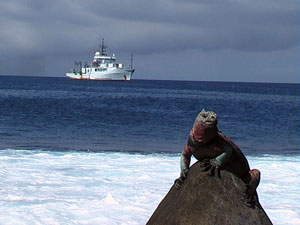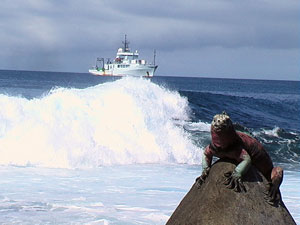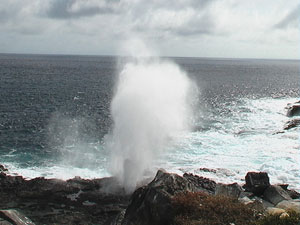|
26 January 2006, Thursday
Blog by Xyrone Ocampo
We started out the day doing sampling at
San Cristobal
Island
, at a place called Puerto Baquerizo Moreno. This was Joni’s sampling site, which consisted of a CTD cast, Van Veen Grab, and a net tow at six different positions. Joni took three of the positions using the Zodiac small boat, and the other three were aboard the Thompson. We then left around
noon
southward to the
island
of
Española
, so that the whole crew could visit a place called Punta Suarez. This place had probably the most picturesque views of all the sites we have been so far. The curling waves crashing amongst the rocks, along with compressing water between smaller cracks to create 20-foot high blowholes were definitely the highlight of this site. Española is located on the southeast corner of the Galapagos Archipelago, so my assumption is that it may be one of the oldest of all the islands. We saw Nazca Boobies, which are one of the three types of boobies in the islands, the Galapagos Hawk, whose role is atop the food chain here in the islands, and more sea lions and marine iguanas. I also saw a pair of American Oystercatchers, a native bird, with their baby. We left Punta Suarez just after 1900 local, and headed southeast toward my (Xyrone’s) first station located at 2ºS 089ºW to find the signature of the EUC east of the Galapagos. I felt bad for a few people because we were traveling parallel to a few large swells, which created a slow, long rocking motion, and they became (if they weren’t already) seasick. The swells we were feeling may have originated from the Antarctic region, but who knows? We arrived just after one in the morning, and the deck outside on the starboard side became busy again. The midwatch crew, consisting of Jaqui, Katy, and myself, along with Tasha, Diego, Seelye, Gabrielle, and Llyd, began the evolution with a 400m CTD cast. This was to be Tasha and Katy’s last station, and then we did a surface net tow and net drop to 180m. Afterwards, we deployed the iridium float to watch it drift along 100m depth. Our trip will go along the 089ºW longitude for the next day, more to follow tomorrow.

|

A marine iguana ignores the Thompson




|